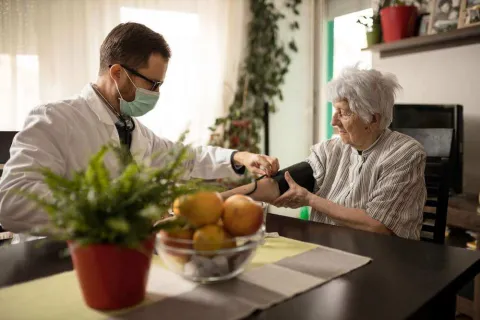3 Roles of Advanced Practice Nurses in Their Communities

Advanced Practice Registered Nurses (APRNs) play a critical role in the delivery of health care and are essential to improving patient outcomes in many communities. Since the role of Nurse Practitioner (NP) was established in the 1960s, many nurses have gravitated to the role as a way to serve a variety of patient populations, delivering care in a range of settings. There are many ways that APRNs can enhance the quality of patient care, and these are associated with the various nursing career paths that are available.
One way to think about how NPs can be instrumental in improving their communities is to imagine spheres of influence. For NPs who are providing direct clinical care, their patients are their primary sphere of influence. NPs who act as nurse leaders or nurse educators have a sphere that includes other nurses and staff or nursing students. Nurse practitioners who undertake advocacy have an even wider sphere of influence as they use their skills in policy, research and understanding of nursing outcomes to effect change in the local community or on a state or national level.
Depending on the nursing career paths chosen by the nurse practitioner, these spheres of influence do not have to be separate—they can intersect, overlap and change over time as one’s career progresses.
What unites them is the NP’s sense of purpose.
Here are three roles that nurse practitioners can fulfill to benefit their communities.
1. APRNs are a primary point of care
As they complete their education, Advanced Practice Registered Nurses select one or more specializations determined by the population they wish to care for, and whether they prefer acute or primary care as their area of emphasis.
The percentage of NPs who provide primary care is about 70% of all nurse practitioners, according to the American Association of Nurse Practitioners (AANP). These specialties include Adult-Gerontology Primary Care Nurse Practitioners (AGPCNPs), who work with adults from late adolescence through senior years; Women’s Health Nurse Practitioners (WHNPs), who focus on women’s health, including reproductive concerns and more; and Pediatric Nurse Practitioners (PNPs), who concentrate on the youngest patients, from neonates to teens.
Most APRNs who chose a role as a nurse practitioner choose to be certified as Family Nurse Practitioners (FNPs). According to the AANP, FNPs make up 69.7% of all nurse practitioners. FNPS practice in a variety of settings, including urgent care, walk-in clinics, school-based clinics, public health clinics, clinician offices and from their own private practices.
FNPs are often the primary point of care for many people in underserved communities, including urban areas and rural communities. This has been true since the role was established 50 years ago—many people outside of metropolitan areas were not receiving health care because of a lack of physicians serving in those locations. That decline in the number of physicians providing primary care continues to this day, as many of them choose to pursue specialization instead of general medicine. Nurse practitioners who have achieved “an expert knowledge base, complex decision-making skills and clinical competencies” are able to meet the needs of many communities that would otherwise have no primary care.
On the whole, U.S. patients have not had any negative feelings about this transition. Patients have consistently expressed higher satisfaction with the care they have received from NPs than from medical doctors (MDs), doctors of osteopathy (DOs) and physician assistants (PAs), as was borne out in a 2019 survey comparing the four types of providers.
2. An advocate for good health in the community
Because FNPs see patients across the lifespan, they can be highly attuned to forces, events or resources that affect the health of community members. For example, an FNP in an urban area that has lost its only grocery store may find that patients have a harder time controlling diabetes or maintaining a healthy weight due to the lack of fresh food. Or an FNP in a Rural Health Center (RHC) may find stress-related illnesses rise when severe weather events ruin a harvest.
In these examples, FNPs can play multiple roles. First, consistent with a patient-centered approach to care, they work with patients to address immediate health concerns. Second, FNPs can work with governmental and non-governmental organizations through clinical-community linkages to improve community health outcomes, advocate for critical policies and resources and provide public health education. FNPs are educated in evidence-informed practice and can employ its key principles (research skills, clinical skills and patient input) to support reasoned policymaking.

3. An advocate for full practice authority
Nurse practitioners can also serve another community—their own professional community. Working with other NPs and organizations committed to their success, nurse practitioners are advocating for full practice authority in states where their scope of practice is reduced or restricted. Currently, nurse practitioners have full practice authority in only 24 states and the District of Columbia. This means that they can make clinical care decisions for their patients without immediate supervision of an MD. In the remaining states, licensure laws either reduce the ability of NPs in one or more aspects of practice (by requiring collaborative agreements with a physician to write prescriptions, for example) or restrict at least one element of practice by requiring physician “supervision, delegation or team management.”
Studies have shown that these limitations on an NP’s scope of practice do not affect patient outcomes. As stated in one study of Rural Health Centers, researchers report “no statistically significant difference was found in patient outcomes for RHCs in reduced practice states compared to those in restricted practice states. Yet, expanded scope of practice may improve provider supply, health care access and utilization and quality of care.”
The same paper concluded, “Although this study found no significant relationship between Advanced Registered Nurse Practitioner (ARNP) scope of practice and select patient outcome variables, there are strong indications that the quality of patient outcomes is not reduced when the scope of practice is expanded.”
When patient care from NPs is trusted, effective and, as studies have shown, provided at a lower cost, advocating for full practice authority is a logical pursuit.
Start Your Nursing Career at Marymount University
The entry-level option for students with non-nursing undergraduate degrees is the Online ABSN. In just 16 months, Online ABSN students complete the following requirements in preparation for RN careers:
- An on-campus residency
- Clinical placements in Virginia
- 100% online courses on topics like Research and Evidence-Based Practice
Marymount’s ABSN is accredited by the Commission on Collegiate Nursing Education (CCNE). Nursing courses at Marymount are taught by practicing APRNs who can speak with authority about the profession. The university’s stellar reputation is confirmed by top U.S. News & World Report rankings in its National Universities and Nursing categories.
If you want to become an RN, contact one of our student advisors to discuss if this program is right for you.
